Exposure measurement
By Brent Stephens on February 15, 2015
My colleague Michael Waring, who directs the Indoor Environment Research Group at Drexel University, recently shared a thought with me. He was thinking about compiling a list of about 20 papers that every graduate student in his group should read and be very familiar with. It’s a great idea, so here I am doing the same.
Below is a list of 20 papers I think every Built Environment Research Group student (BERGer) should read. Narrowing to only 20 papers is tough. In fact, this may forever be considered a rough draft of a list, and it will most certainly change or expand over time. But I have chosen these articles to span a wide range of topics related to energy and air quality in the built environment, including the physics or chemistry of indoor air pollutants, human exposure to indoor pollutants and health effects, and energy efficiency in buildings. There may be other even better articles on each topic, but these were chosen for their combination of impact on research and thought in their areas of inquiry, the usefulness of their methods, their clarity in presentation, and for the references included within them as well as their links to other papers that have referenced them upon publication.
Continue Reading →
Filed under: Building science | Doing research | Energy efficiency | Environmental health | Experimental methods | Exposure measurement | Indoor air pollution | Infectious disease | Literature round-up
By Brent Stephens on May 1, 2014

We recently partnered with investigative reporter, Dave Savini, from CBS 2 Chicago to make air quality measurements in and around Metra trains and train stations in downtown Chicago. The Chicago Tribune had previously reported high concentrations of soot (black carbon particles) onboard trains over 3 years ago, which were thought to be caused by re-entrainment of diesel engine exhaust. We know that diesel exhaust emits a number of pollutants that are problematic for respiratory and cardiovascular health, including ultrafine particles, black carbon particles, metals, and VOCs and SVOCs. This report prompted Metra to take action, primarily by installing particle filters on the cabin ventilation systems (MERV 13 instead of MERV 8) and by installing (or planning to install) devices that shut-off the diesel engines as they enter stations. The filters were shown in 2011 to measurably reduce black carbon particle concentrations in the rail cars, which was good to see. I’ve also found links to documents showing that Metra was upgrading ventilation systems to include vent hoods on intakes and exhausts, manual closing of outdoor air dampers, and exhaust deflectors on the locomotives themselves. I’m not sure of the status of these repairs or the extent to which MERV 13 filters have been installed across the fleet.
UPDATE: Watch a video of the CBS 2 story
Continue Reading →
Filed under: Environmental health | Exposure measurement | Indoor air pollution | Local to Chicago
By Brent Stephens on April 23, 2014
In case you aren’t familiar with this report, I’m simply linking to the 2009 EPA Integrated Science Assessment for Particulate Matter (direct pdf download) here because I find it to be an extremely exhaustive look at the nature of airborne particulate matter, aerosol science, sample collection methods, geographic differences across the U.S., inhalation and respiratory deposition, and acute and chronic health effects. I’ve taught from it directly and I’ve used it to inform research and my own opinions on PM exposures. It weights in at a whopping 2,228 pages! Here are a few screenshots of what I find to be some of the most helpful parts:
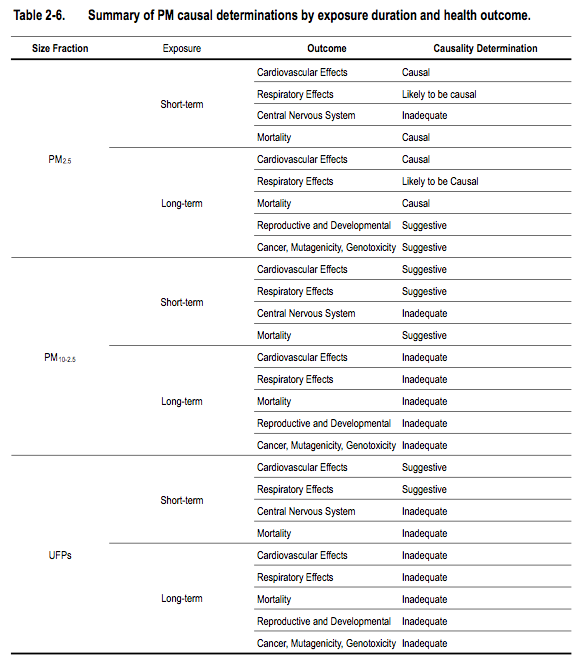
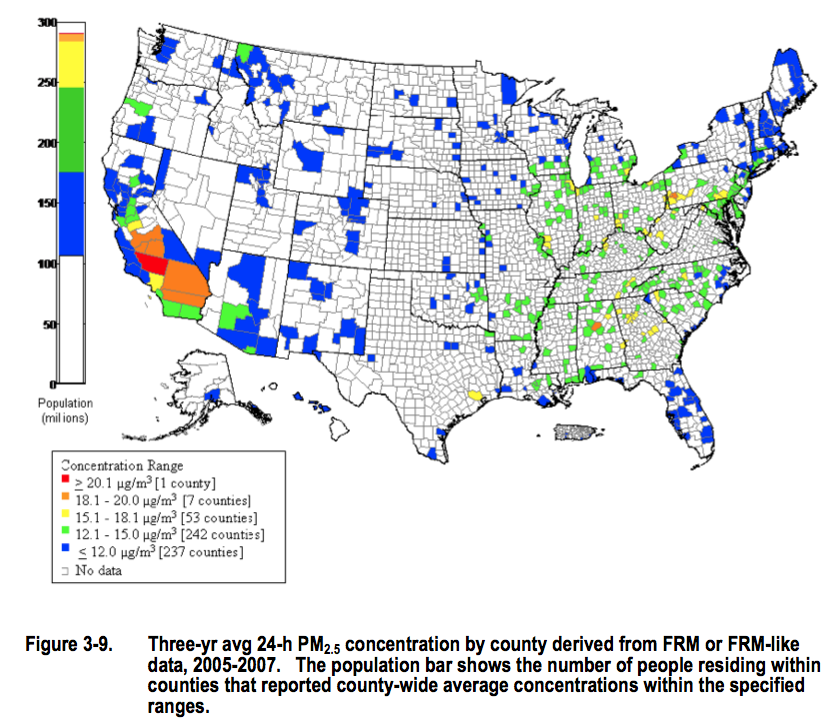
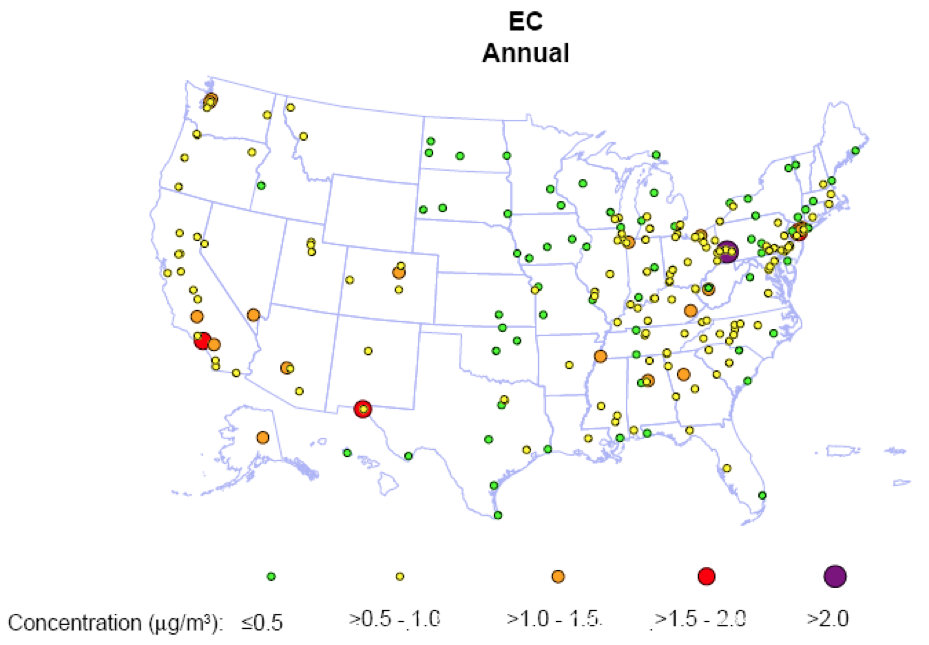
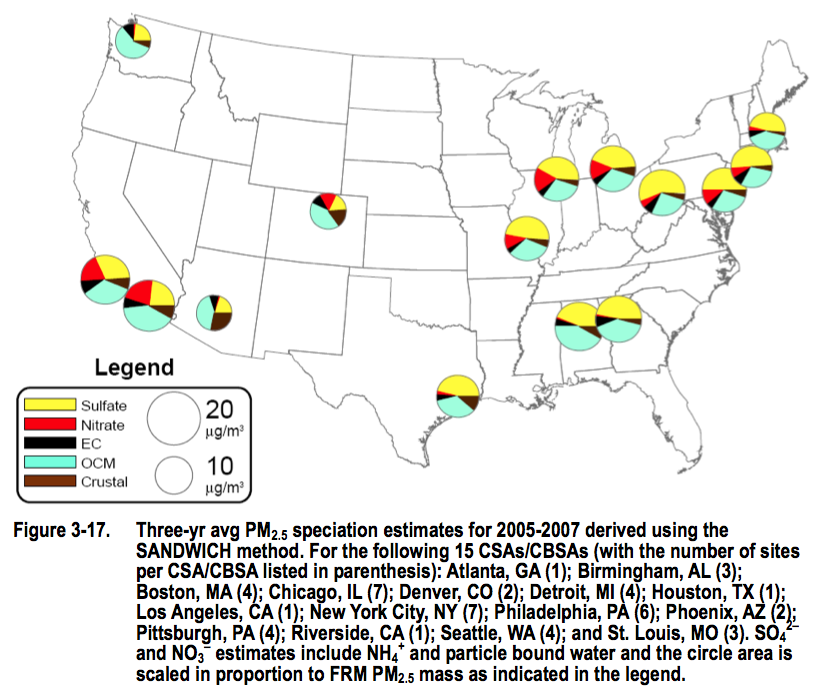
Filed under: Environmental health | Exposure measurement | Particulate matter
By Brent Stephens on November 22, 2013
I haven’t posted one of these literature round-ups since June. The last one was right before I post in which I said “I’m going to start blogging more!” That turned out to be completely false, but now that our semester is wrapping up, I thought I’d try to jump back in! So here are a few recent papers related to building science, energy, environment, and health that have sparked my interest:
- Improving airflow measurement accuracy in VAV terminal units using flow conditioners – A good friend and colleague of mine Michael Waring at Drexel recently published an article with coauthors on using a simple flow conditioner to make airflow measurements in HVAC systems more accurate, reducing errors from 10-45% (depending on nearby elbows and kinks) to about 5%.
- Human exposure to airborne particulate matter leads to oxidative DNA damage
- Both soil and paint contributes to lead levels in Australian homes
- Particle size distributions form e-cigarettes – Always controversial, this team measured particle concentrations and particle size distributions in mainstream smoke from electronic cigarettes under a range of liquid flavors, liquid nicotine contents, and “puffing times.” Particle size distributions peaked around 120-165 nm, similar to conventional cigarettes. Resulting particle concentrations were actually higher than a conventional cigarette. Flavor didn’t matter.
- Meta-analysis of high penetration renewable scenarios – A meta-analysis of several studies evaluating the possibility, operability, and implications of high levels of renewable sources of electricity in grid scale power systems shows that in most regions, renewable sources can provide the majority of a country’s or region’s electricity demand, at least on an hourly scale.
- Systemic and vascular effects of circulating diesel exhaust particulate matter – Diesel exhaust particles (DEPs) were shown to increase inflammatory responses when they enter the bloodstream. Also, DEPs were shown to be quickly sequestered in the spleen and liver in mice.
- Fine particulate matter from urban areas was shown to generate a higher reactive oxygen species (ROS) response than rural and/or coarse PM – responses were independent on PM chemical composition.
- Fine and ultra fine particle decay rates in homes – Using time-resolved data over the course of 1 week in 74 homes in Edmonton, CA, Wallace et al. used concentration peaks and subsequent decay periods of both PM2.5 and submicron particles (representative mostly of ultra fine particles), to estimate decay rates. Median and interquartile decay rates were 1.08 per hour (IQR: 0.62-1.75 per hour) for PM2.5 and 1.26 per hour (IQR: 0.82-1.83 per hour) for submicron particles. Air exchange contributed about 25% of these values, on average. Window opening, home age, use of central furnace fans and kitchen/bathroom exhaust fans, use of air-conditioners, use of air cleaners, and indoor-outdoor temperature differences all influence these values.
- Diversity and distribution of fungi on residential surfaces – Rachel Adams and coauthors sampled fungi from 3 surfaces in homes: drains in kitchens and bathrooms, sills beneath condensation prone windows, and the skin of human occupants. Weedy genera and a large set of fungi likely of outdoor origin were found on the window sills; human foreheads contained a surprising amount of plant pathogens. Indoor fungal richness was generally high, but the authors conclude that most fungi were unlikely to be growing on the surfaces but are more likely to have been deposited/settled from other sources.
- Asthma and the diversity of fungal spores in air – many studies in the past have found correlations between asthma symptoms and exposure to fungi indoors; this short article highlights some of that past work and suggests that by doing more species identification we will be able to learn more about which fungi species contribute to asthma and inflammation
- Low fungal diversity in house dust is associated with childhood asthma development – Somewhat contrary to the previous paper, a new study of low-income children whereby house dust was collected at age 1 and asthma status determined 6 years later. Although the study had a small sample size of 13 cases and 28 controls, decreasing fungal diversity within the genus Cryptococcus was significantly associated with increased asthma risk. No fungal taxon (species, genus, class) was positively associated with asthma development. Hmm…
- PVC flooring at home and development of asthma in young children – Last article on asthma this time… in a 10-year follow up study of children in Sweden revealed that children who had PVC floorings in their bedroom at baseline (when hey were 1 to 5 years old) were more likely to develop asthma during the following 10 year period than compared to children without PVC flooring. Exposure to PVC flooring – and the phthalate plasticizers emitted – during pregnancy may be critical to development of asthma in children later on.
Filed under: Environmental health | Exposure measurement | Indoor air pollution | Literature round-up | Particulate matter
By Brent Stephens on June 11, 2013
Much of my work over the last few years has been focused on improving methods to assess our indoor exposures to outdoor airborne pollutants. This is driven in part by the fact that we spend so much time indoors (and so much time at home) and that different pollutants can infiltrate indoors in different ways; at the end of the day, much of our exposure to outdoor air pollution actually ends up occurring indoors. Another motivator is that there are wide variations in some of the fundamental drivers of indoor proportions of outdoor pollutants, particularly in homes, that I don’t think have been captured very well to date. Air exchange rates are certainly higher in leakier buildings and we understand how to model these fairly well (although not as well as you might think), but good data on envelope penetration factors in a large number of homes are limited. We also don’t know a ton about HVAC filtration, system runtimes, indoor deposition rates, and the least academic yet probably most difficult of all to assess: window opening behaviors.
With all that said, we’re working on a handful of projects (and have a few related proposals under review) that would work to improve our knowledge of some of these drivers (as well as our predictive ability). Also, I noticed a couple of papers out in the Journal of Exposure Science and Environmental Epidemiology that continue to move this kind of work forward. I thought I’d share them here.
1. Breen et al. (2013) published a review of the models that can be used to estimate air exchange rates in buildings. They review driving forces (e.g., I/O temperature differences, wind speed, and mechanical ventilation) in conjunction with the leaks/openings through which driving forces can force airflow. Then they review a handful of models with varying levels of details and input parameter needs for estimating air exchange rates in buildings. They finish up with a list of advantages and disadvantages of each method and describe ongoing research needs. This is a very helpful paper for understanding how airflow can be assessed and ultimately used to impact exposure assessment for epidemiology.
2. Hodas et al. (2013) published a study where they used existing epidemiological data for myocardial infarction (heart attack) associations with elevated outdoor particulate matter (PM2.5). However, instead of using only outdoor concentrations, they accounted for variations in indoor proportions of PM2.5 across a variety of homes (related to the paper above!), as well as for time spent at home, in order to explore whether or not accounting for indoor exposures altered the outcome (accounting for differences in air exchange rates only). Interestingly, they didn’t observe differences in the exposure-response outcomes for those with different air exchange rates in their homes, but primarily because they used data from a “case-crossover” study whereby occupants are their own controls. That is to say that they track the same occupants in time with different exposures; therefore, it makes sense that indoor proportions of outdoor PM2.5 may be always consistent within a particular group, so building factors are in a sense controlled for in each “case”. They did however observe differences in the relative odds for heart attack for those in leakier homes, as occupants of leakier homes (with higher air exchange rates and thus higher indoor proportions of PM2.5 that would otherwise have not been accounted for using central site data). They conclude with “These ?ndings also illustrate that variability in factors that in?uence the fraction of ambient PM2.5 in indoor air (e.g., AER) can bias health effects estimates in study designs for which a spatiotemporal comparison of exposure effects across subjects is conducted.” Very much a motivator for the work we’re doing!
3. Baxter et al. (2013) actually preceded the study above by comparing the performance of a few different models for predicting indoor proportions of outdoor PM2.5 in homes — the models largely vary by the way they account for different air exchange rates in homes (related back to the first study here). Again, results suggest that differences in residential exposures may be important for epidemiology studies, and importantly, not captured by outdoor monitors alone. These kinds of studies again motivate me to get out there and develop better ways of assessing some of the inputs to these models (which are not always captured well) with our knowledge of building science to ultimately inform epidemiology studies and improve our decision making for regulatory purposes.
Enjoy!
Filed under: Experimental methods | Exposure measurement | Literature round-up | News | Particulate matter
By Brent Stephens on December 13, 2012
I have been spending much of my time recently working on a project for the National Air Filtration Association (NAFA). The goal is to review literature on the transmission of infectious diseases and explore what kinds of impacts that HVAC particle filters may have on the transmission of infectious aerosols. It’s a wonderfully interesting project that I’m happy to be working on. But it has also sent me digging into a world of literature that I previously didn’t know existed.
For example, I’ve known that there has been a long running debate about whether infectious diseases are transmitted primarily via (i) inhalation of airborne aerosols, (ii) contact with contaminated surfaces, or (iii) some imprecise mixture of the two. In digging in this field, I came across a paper today that details an amazingly absurd, yet extremely helpful, set of experiments.
Check out the following statement from Dick et al. (1987). Aerosol Transmission of Rhinovirus Colds. The Journal of Infectious Diseases. 156(3):442-448:
Twenty-seven to 34 men >18 years of age were inoculated intranasally with 560-2400 TCID50 of safety-tested RV16 [i.e., rhinovirus, or a virus that leads to the common cold] by pipette and spray on two successive days. On the third day, eight men with the most severe colds (donors) played stud and draw poker with 12 antibody-free … men (recipients) between the hours of 8 a.m. and 11 p.m.
Going on…
In experiments A-C the donors and six of the 12 recipients played cards naturally and used cloth handkerchiefs for secretion, cough, and sneeze control, whereas the remaining six recipients in each experiment wore devices that blocked completely all hand-to-head movements.
Did you catch that? A group of men were taken into a lab and injected with cold virus. Then the following day, those men were put together in a room with 12 healthy uninfected men where they played stud and draw poker all day long! The catch was that half of those healthy men were able to touch their faces and behave quite normally; the other half were restrained by these braces such that they couldn’t touch their faces!
This is such an absurd but beautifully constructed experiment to me. I don’t even know if you could get IRB approval for something like this any more. I can just imagine the conversation that led to this experiment. “What if we take a bunch of people, infect them, then make them play poker for 12 hours. Half the people they play poker with can blow their nose, touch their faces, etc., and the other half will be physically restrained — but only to the point where they can’t touch their face… they can still play cards!
In the end, their results are extremely important to the debate on airborne vs. surface transmission of disease. They reported no significant difference between the two groups, suggesting that aerosol transmission must have been the dominant route. Amazing!
Filed under: Experimental methods | Exposure measurement | Infectious disease | Particulate matter
By Brent Stephens on May 7, 2012
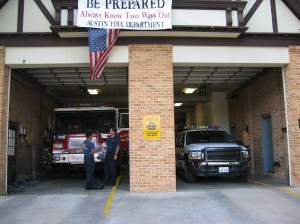
Fire station in Austin, TX
Last week I assisted a team of graduate students during a visit to a fire station in Austin, TX. The students were from Dr. Atila Novoselac‘s Energy and Indoor Air Quality Field Measurements course at the University of Texas at Austin. The students were measuring concentrations of particulate matter in the station in order to assess firefighters’ exposures to diesel exhaust.
Continue Reading →
Filed under: Exposure measurement | Particulate matter






